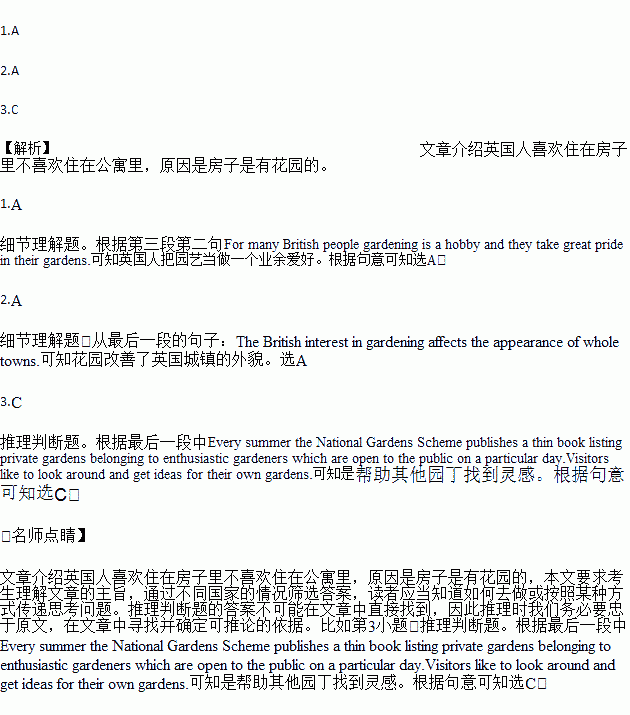题目内容
Most British people prefer to live in a house rather than,a flat and one of the reasons for this is that houses usually have gardens.The garden is a place where people can be outside and yet private.
If a house has a front and back garden,the front is likely to be formal and decorative,with a lawn (an area of grass) or fancy paving and flower borders.The back garden usually also has a lawn and flower beds,and sometimes a vegetable land or fruit trees.There is often a bird table (a raised platform on which food is put for birds) and a shed in which garden tools are kept.
Many British people spend quite a lot of money on their gardens and even the smallest may contain many kinds of flowers and plants.For many British people gardening is a hobby and they take great pride in their gardens.Some towns and village have competitions for the best-kept small garden.People with a small garden,or no garden at all can rent a piece of land,on which most people grow vegetables.
There are garden centers near most towns,selling everything a gardener might need,from flowerpots to fish ponds as well as different plants.
The British's interest in gardening affects the appearance of whole towns.Public parks and traffic roundabouts often have bright displays of flowers in summer and public buildings have window boxes(窗口花坛)and hanging baskets.Towns and villages enter for the yearly Britain in Bloom competition.
At weekends many British people like to visit famous gardens,such as that at Stowe near Banbury,built in the 18th century.Every summer the National Gardens Scheme publishes a thin book listing private gardens belonging to enthusiastic gardeners which are open to the public on a particular day.Visitors like to look around and get ideas for their own gardens.
1.What is Paragraph 3 mainly about?
A. The British love gardening as a hobby.
B. The British spend too much money on touring.
C. Poor British people cannot afford gardening.
D. The British like showing off their gardens.
2.What can we know from Paragraph 5?
A. Gardening improves the appearance of British towns.
B. British parks are full of flowers all year round.
C. The British's interest in gardening is decreasing.
D. Britain in Bloom is a worldwide competition.
3.Why does the National Gardens Scheme offer information on private gardens? .
A. Call on gardeners to compete with each other.
B. Point out the importance of private gardens.
C. Help other gardeners find inspiration.
D. Make the gardeners better-known.


 t always easy.
t always easy. , they often reach excellent academic results.
, they often reach excellent academic results.